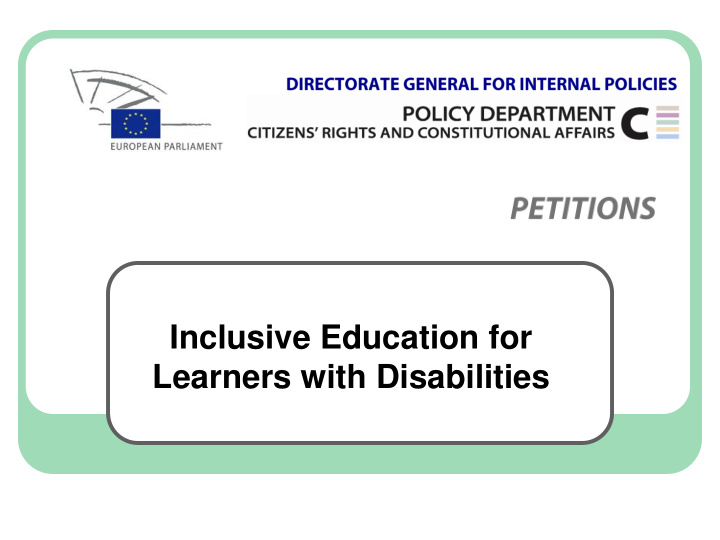



Inclusive Education for Learners with Disabilities
Presentation by Serge Ebersold European Agency for Special Needs and Inclusive Education Professor at the Conservatoire National des Arts et Métiers (CNAM), Paris, holder of the chair accessibility Policy Department C Responsible Administrator: Jos HEEZEN jos.heezen@europarl.europa.eu
Inclusive education is a national theme/issue and its understanding varies among countries a strong policy goal for countries and many increased their spending on it despite financial constraints strongly supported by international organisations
Combining performance and equity through inclusive education
Inclusive education is a response to increasingly complex and diverse societies and requires that diversity is seen as an asset to combine performance and equity ‘one -size-fits- all’ moves away from a education model towards a tailored approach to education
Inclusive education (ctd) relates learners’ difficulties to schools’ inabilities to compensate for different starting positions, rather than to individual weaknesses requires schools to develop inclusive learning environments that are both universally accessible and adapted to each learner’s needs
Inclusive education as a mean for implementing the right to education (Ebersold, 2017)
• IE as a process • IE as a • Learners’ placement in involvement and education well being • Protection • Protection through through access participation in to education education Equal equal access learning opportunities opportunities • IE as an Equal Equal • IE as a social outcome of citizenship achievement cohesion factor learning opportunities opportunities • Skills for active • Performance participation and equity • Protection • Protection through through inclusion into success in society education
Most learners with disabilities access mainstream education
Percentage of learners with an official decision of SEN in inclusive settings (European agency, 2017 )
A trend towards inclusive education rooted in development of personalised learning and flexible teaching strategies
Resource allocation mechanisms framing inclusive education (European agency, 2016)
A need for labelling learners that varies among countries
Percentage of learners with an official decision of SEN (European agency, 2017)
The need for labelling depends on the enabling effect of existing systems for inclusive education
Systems for inclusive education include a specific framework dedicated to inclusive education special provision for learners with whom the general education system faces difficulty non-educational aspects that impact upon learners’ access to high -quality inclusive education
financial means and support for families are far more complex than the general education system
Effectiveness of inclusive education depends on how the different system components are interconnected and embedded in integrated systems their ability to empower stakeholders to act inclusively for learners and their families the enabling effect of governance, accountability, monitoring and capacity building mechanisms
To summarize inclusive education is rooted in an inclusive education agenda promoting efficient, cost-effective and equitable systems for inclusive education decentralised education systems promoting flexibility at local and school levels, as well as within delivery
To summarize inclusive education is rooted in a preventive approach to inclusive education • aiming to avoid exclusionary strategies • focusing on the enabling effect of capacity- building mechanisms. governance and accountability mechanisms aiming to label the system instead of the learner
Some references
European Agency for Special Needs and Inclusive Education (2016), Financing of Inclusive Education: Mapping Country Systems for Inclusive Education, (S.Ebersold, ed.), European Agency, Odense, Denmark European Agency for Special Needs and Inclusive Education, European Agency Statistics on Inclusive Education (2017): 2014 Dataset Cross-Country Report, (J. Ramberg, A. Lênâ rt, and A. Watkins, eds.), European Agency, Odense, Denmark, Ebersold, S., Ê ducation inclusive : privilé ge ou droit? Accessibilite ́ et transition juvê nile, Grenoble, Presses Universitaires de Grenoble, 2017
Thank you for your attention Serge@european-agency.org
Recommend
More recommend